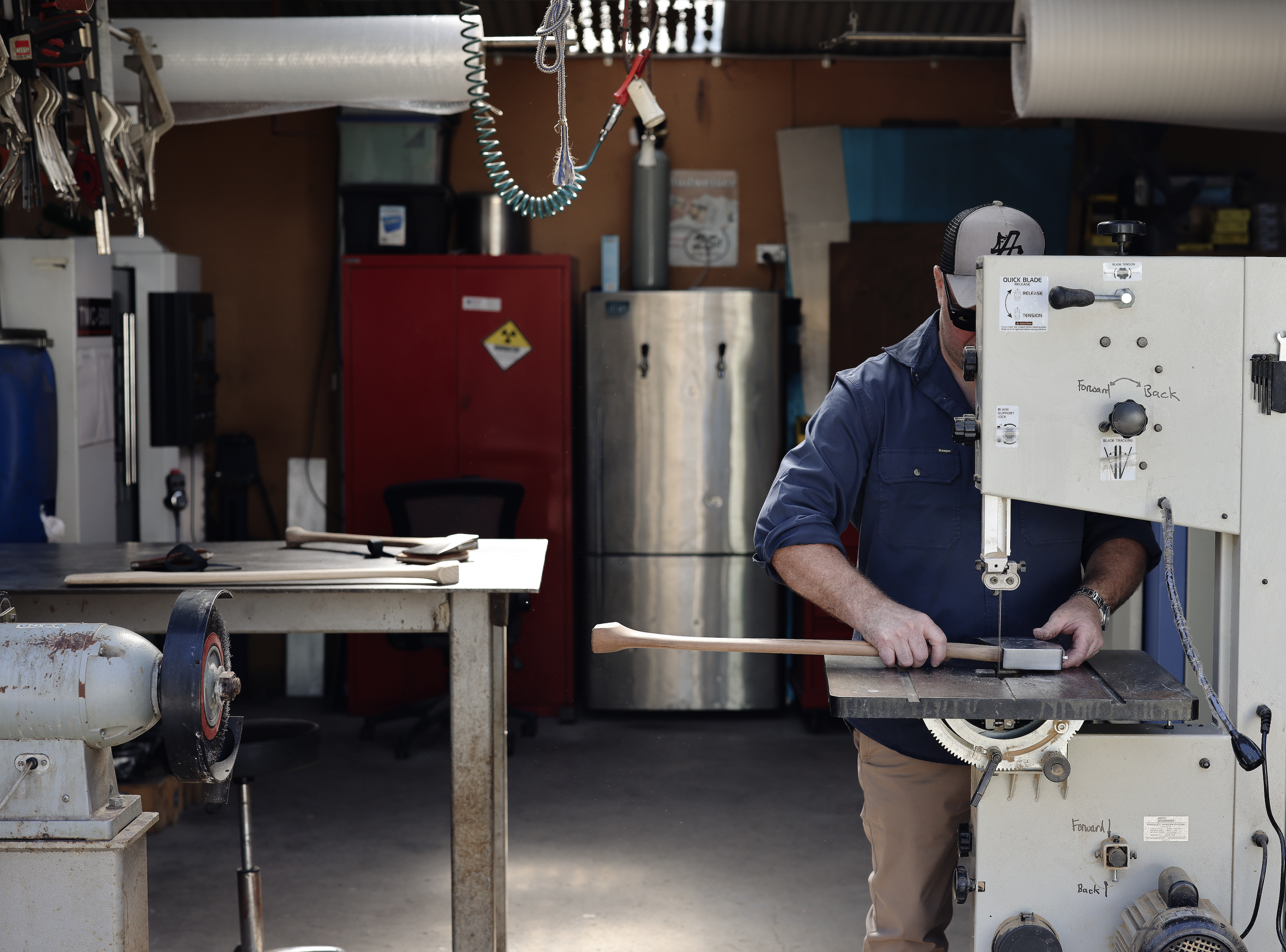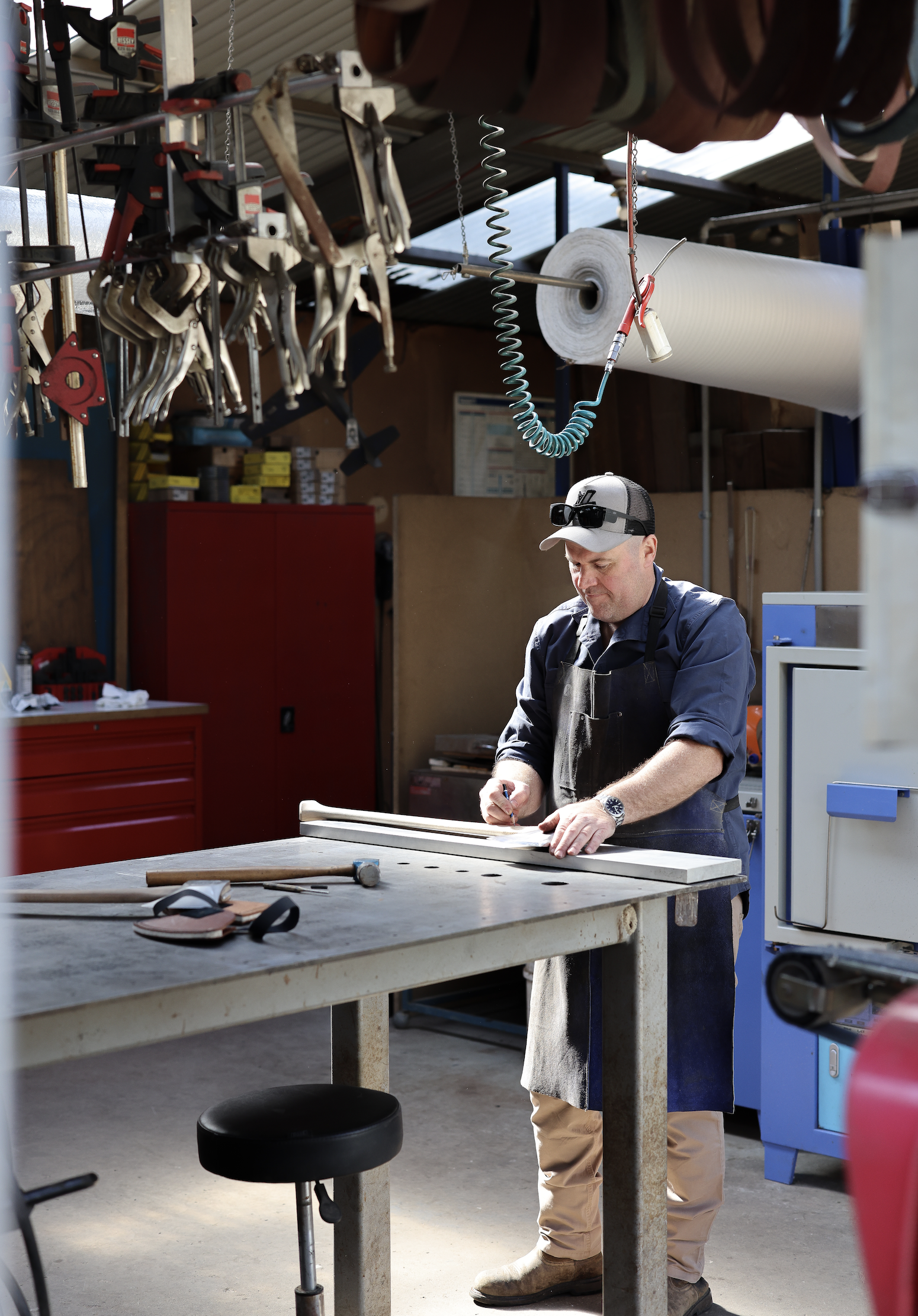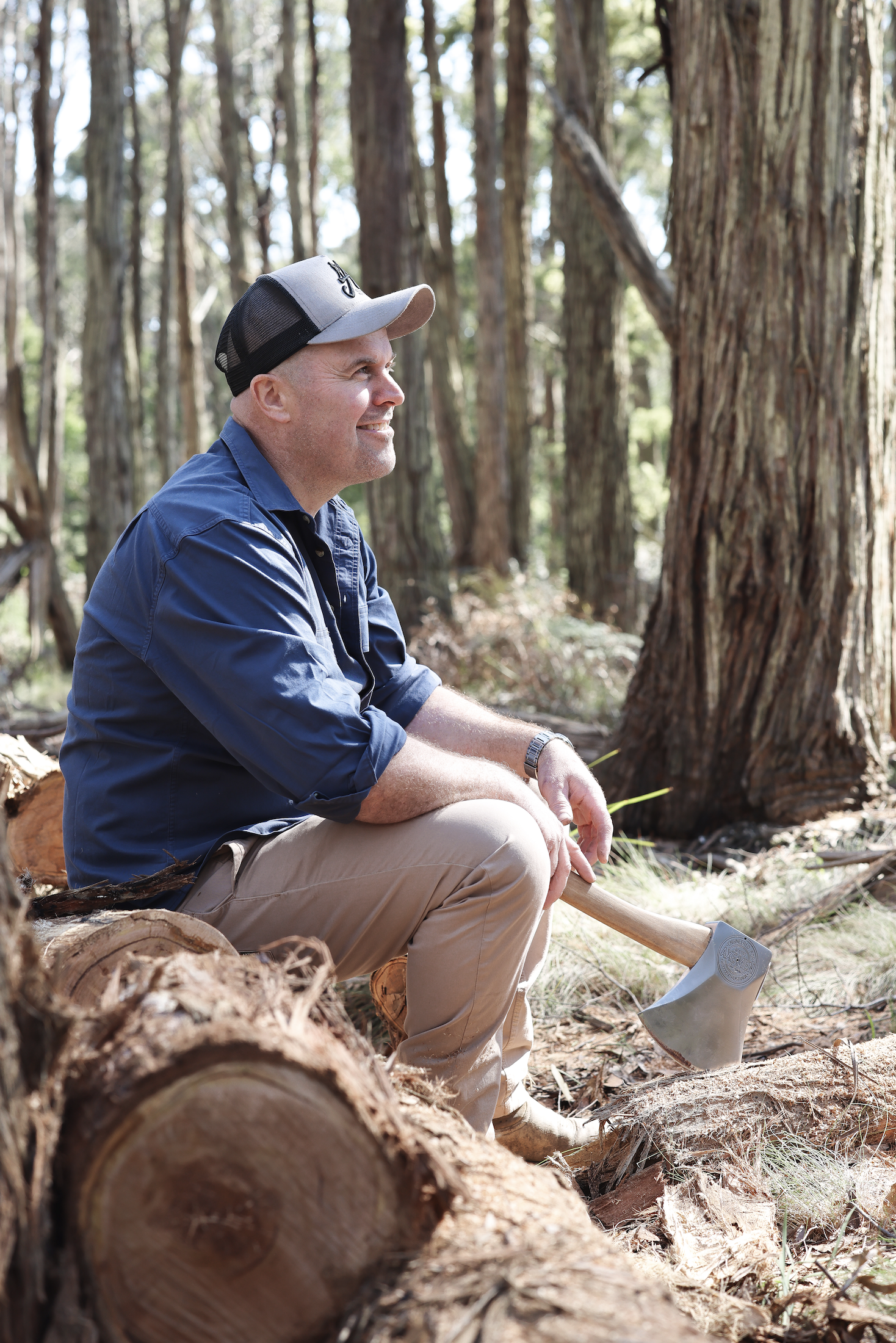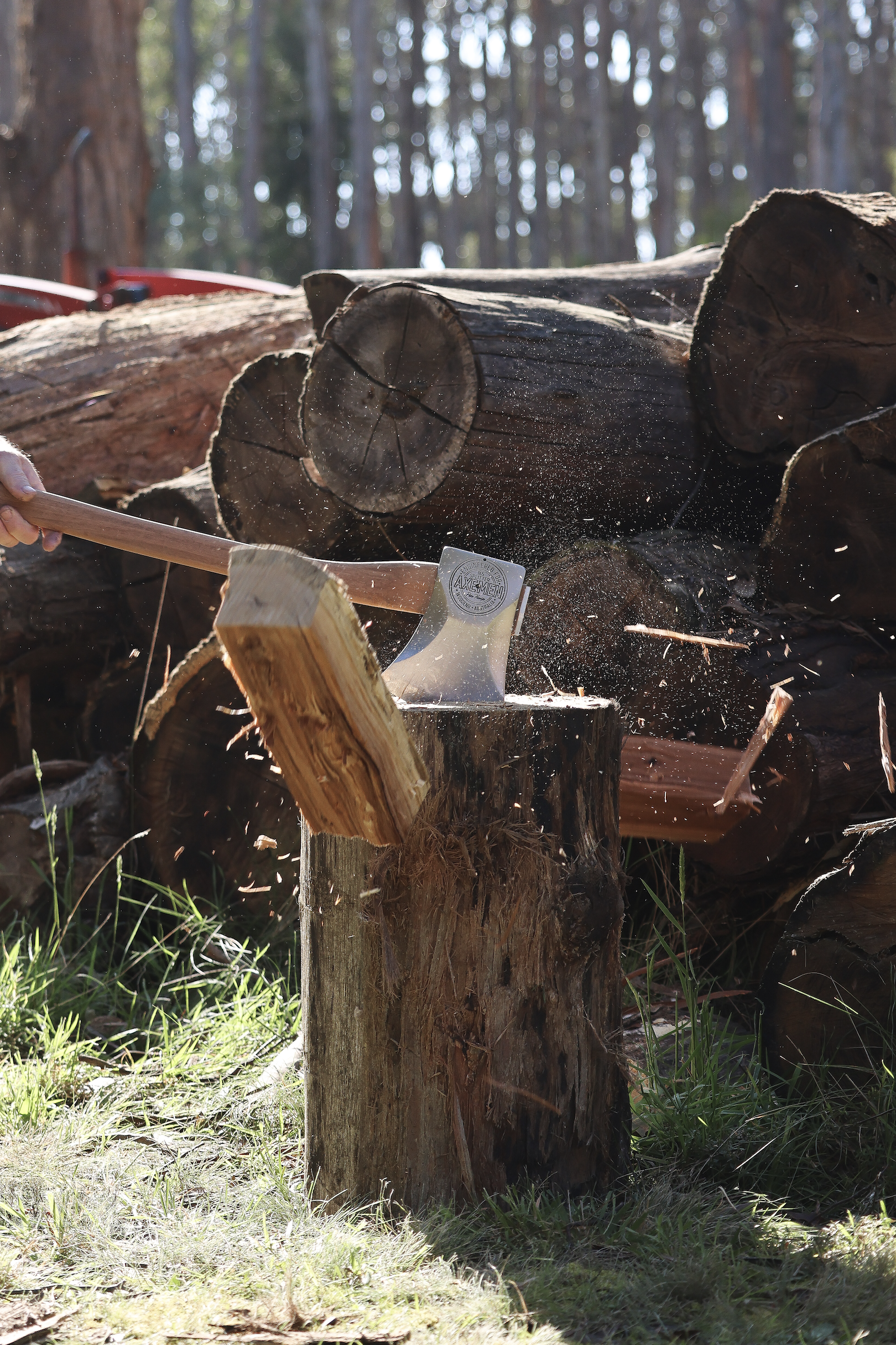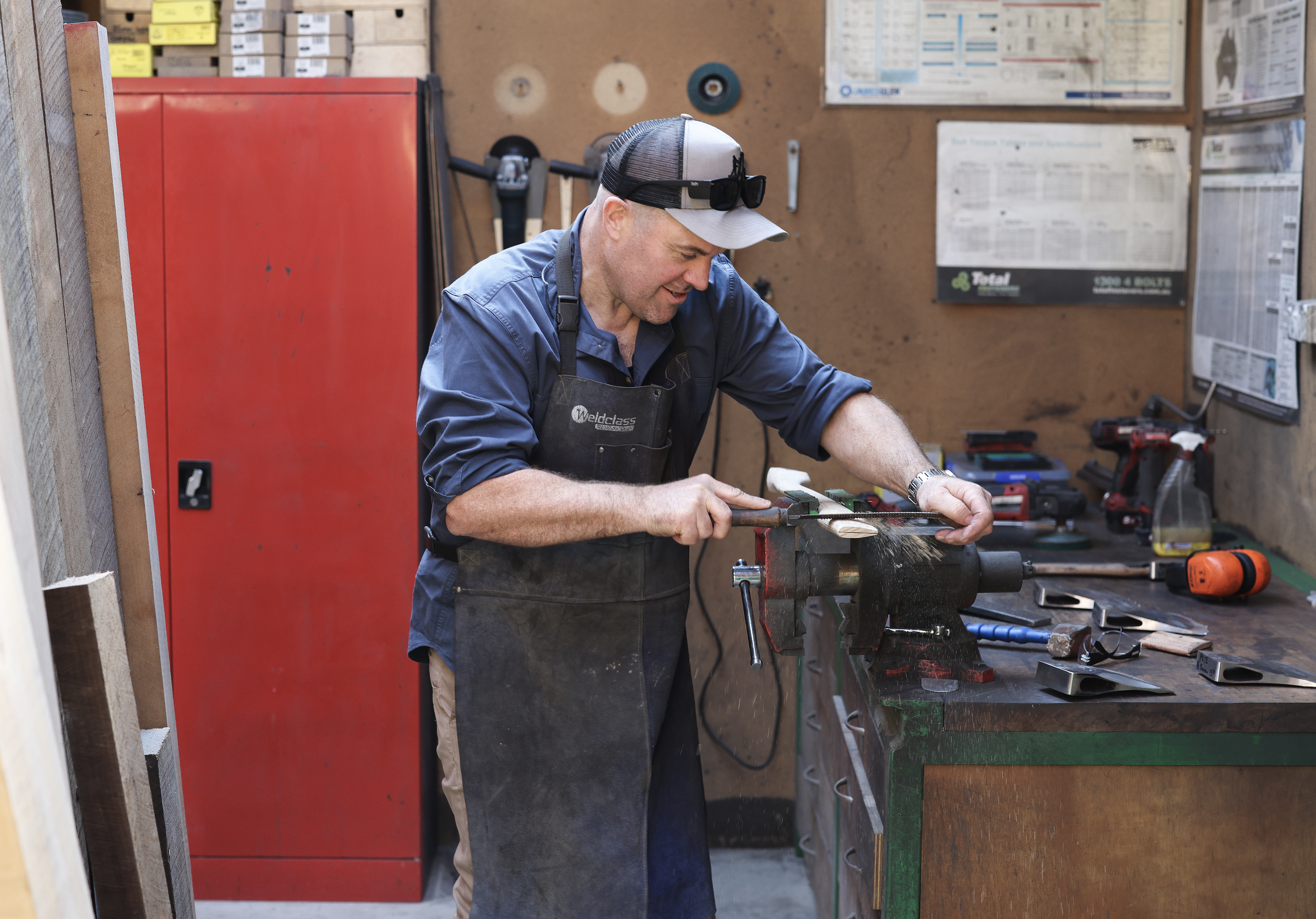Engineered For Axemen
Article by Clara Gatwick Photography by Francesca Kaye
The craft of an axe has been a central part of humanity for centuries. The solid thump and crack of timber. The satisfaction of a good split is universal to all those from the competitive wood-chopping world to a cold winter’s afternoon spent chopping firewood. An axe is a central part of any woodchopping experience. Australian Made and a quality product, Engineered for Axemen have revolutionised the world of axes.
Pere Flentje evokes images of the Tinman from The Wizard of Oz. Tall. Set in his ways. Remarkably galvanised.
The owner of Engineered for Axemen can often be found swinging an axe. But he isn’t silver. And he could probably teach the Tinman a thing or two about competitive woodchopping.
Engineered for Axemen has introduced a change in rhythm to the woodchopping world. A change eagerly embraced from the international stage to small-town country shows.
Pete and his wife Anita are at the helm, crafting specialist axes for professionals and backyard lumberjacks alike. “I often say to people who are a bit unsure, just drop in if you’re close by and have a swing. That’s the best way,” he laughs.
Twelve years ago Pete, a mature-aged student in his last year of engineering at university and procrastinating a bit, signed up for an open-to-all woodchopping competition.
Perhaps luckily for his uni workload, he never heard back.
This is until the thought popped back into his head after finishing his degree. Still eager to give it a go, he called up to ask about it. Unfortunately, there wasn’t a competition scheduled any time soon. But the phone call wasn’t pointless. “My father-in-law teaches woodchopping and he’s only half an hour from you,” the woman on the other end of the line shared.
“Off I went,” Pete says.
Too low on cash to buy the necessary equipment for competitive woodchopping. Pete decided to make an axe box. “It’s more or less an aluminium toolbox we store the axes in. thought I’d make a couple of those to try and sell or trade for axes because they’re really expensive.”
These axe boxes sold at the next woodchop event he took them to.
He made another ten.
And then they sold too.
“It just sort of snowballed from there,” he explains. Still working part-time as an engineer, Pete continued to get requests for other woodchopping equipment.“We made virtually everything.”
“We send them all over the world now,” Pete shares excitedly.
Finding the market in need of something new, they decided to start making axes that were a little different and a little better. And the quality spoke for itself, the axes quickly taking over as the business’s primary revenue.
With a focus on their products being Australian-made, the team get the blank forging done in Melbourne and complete the rest of the process in-house.
First comes heat treatment, which is done in two processes.
This is where Engineered for Axemen is truly a cut above the rest. “Before we started masking axes a lot of people did it the old-school way.” Casting and forging axeheads that weren’t as accurate as everyone wanted.
At Engingineered for Axemen, once the forging has arrived and the heat treatment is completed, they use a computer-controlled CNC (computer nu- merical control) mill that provides a much more precise axehead.
“We do a lot of the hard work with the mill.Then it’s more or less just rough finishing and polishing. We also do the etching and make the handles as well.”
They favour white hickory from the United States for their racing axes and Australian spotted gum for work axes. Pete says, “We’d love to use [more] Australian wood but we haven’t found an Australian timber that works quite as well.”
The work axes are slightly different from those used in competition and a bit more rugged. In technical terms, “the main difference is the geometry”.
“In a work axe,we have to increase the angle so it’s tougher.This means when you’re cutting through dry wood or hitting big knots, they can handle it,” Pete says.
Pete didn’t grow up in the world of competitive woodchopping. But, recall- ing his childhood in rural Victoria, he shares, “My dad and granddad were always cutting firewood and slabbing wood and doing lots of woodwork. So I always had a passion for everything to do with wood.”
“Just not the actual competition side of it,” he laughs. “I’m a first-generation [competitive] woodchopper. There’s not many of them.”
Pete left rural Victoria when he was 20 and worked across Australia doing contract mining. Returning to Victoria 10 years later, he then studied engi- neering. Now, he lives twenty minutes from where he grew up.
Being involved in the competitive side of woodchopping gave Pete useful contacts. “Getting so much feedback from people using the axes means we are constantly evolving.”
During his time in the sport, Pete has seen an increase in female wood- choppers and woodchopping events – a growth that lent itself to another opportunity.
Engineered for Axewomen.
“We were the first ones to come out with the designated axe for the female competitors. Before that women were just getting hand-me-downs from male competitors.”
Slightly smaller and lighter this axe has proven to be extremely popular. “We’ve sold nearly one hundred over the last few years.”
“I reckon the majority of them have gone to the US,” Pete says, citing the growth of the sport and the Women’s Stihl Series.
There’s always an increased demand towards Christmas – they make a good present. The other peak period is around Easter “when a lot of people over- seas start buying, getting ready for their season.”
Of course, running a small business isn’t easy. “Being an engineer, I just want- ed to make things. I didn’t want to do the accounting and marketing and everything else you have to do.”
“It’s stressful and it’s hard work, but it’s quite rewarding too.”
Anita helps with the organisation and processes, “Sometimes I get buried in the shed just trying to make stuff, so it’s good to have someone who can organise things and keep me going in the right direction,” Pete says with a smile.
When asked if anything exciting is in the pipeline, Anita excitedly urges Pete to “mention the wood splitter”. They’ve been testing it for a year and it is the next item to join the range.
Employing people locally and expanding is on their radar, but for the mo- ment it’s just the two of them and the focus is on maintaining a high-quality product.
When you “break it down”, Pete reminds us, all they are trying to do is split wood.
“Sometimes you think, if there was a better way to do it then it would have been done, but you can’t assume that. You come up with something a little bit different.”
And that little bit of difference, that balance between tradition and design, is what makes these products so special.
Engineered for Axemens’ focus is bigger than themselves. “We’re trying to make really high-quality tools that people can enjoy using. And we hope they will be passed down for generations.”
This piece has been created in partnership with Ranger Outdoor, our favourite Aussie workwear brand.
If you’re interested in seeing more of our work - we hope you’ll consider subscribing to our physical paper here.
